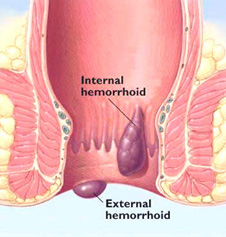Hemorrhoids
What are hemorrhoids?
Hemorrhoids are varicose veins in the anus. They are very common and become more frequent with age. 4-5% of all adults have hemorrhoids. Hemorrhoids are a condition (not a disease) that doesn’t require treatment unless they cause problems (see below).

The figure shows the inner (internal) and outer (external) hemorrhoids. Rubber band ligation can be used for internal hemorrhoids. External hemorrhoids will usually be removed with surgery.
What causes hemorrhoids?
Hemorrhoids are caused by a sustained high pressure in the blood vessels (veins) in the anus. They are typically associated with prolonged constipation or frequent toileting (diarrhea), pregnancy, obesity, prolonged cough, etc.
What problems can hemorrhoids cause?
The most common symptoms are: bleeding, itching, prolapsed mucosa, defecation difficulty, discomfort, hygiene problems and pain.
How do you examine for hemorrhoids?
It is necessary to perform an endoscopy of the rectum and lower part of the colon (a sigmoidoscopy) to evaluate the extent of hemorrhoids and to exclude other diseases. Read more about sigmoidoscopy.
How is the treatment of hemorrhoids?
Constipation, which is a frequent cause of hemorrhoids is best countered with plenty of fluid intake (min. 2.5 liter daily), a high fiber diet and / or fiber supplements. It is very important not to rush when going to the bathroom. Give yourself time enough.
Mild laxatives may be used during periods with obstinate constipation. Remember that constipation in itself also should lead to examination if it has lasted for more than 4 weeks.
The first hemorrhoid treatment can be a treated locally with creams or suppositories, and not necessarily surgery.
Treatment with hemorrhoids agents (eg Proctosedyl, Doloproct) which contain local anesthetics and corticosteroids, are widely used and can relieve symptoms, but do not remove hemorrhoids.
If you must undergo surgery
The simplest of hemorrhoids can be treated with rubber band ligation, but primarily only on internal hemorrhoids. Treatment takes place through a plastic tube, which is introduced in the rectum and must usually be repeated a few times to achieve the best effect. Rubber band ligation is more effective than injections and heat treatment.
For more comprehensive and larger hemorrhoids surgery with removal of hemorrhoids is necessary. Surgery can be performed under local anesthetic. The wounds after surgery are left open and must heal by themselves.
After surgery
As the hemorrhoid wounds must heal by themselves, there may be slight bleeding for a few days after surgery. The bleeding decreases and usually stops within a day. There may be pain of varying intensity for several days, and it is a good idea to have painkillers at home. We recommend 2 pieces of Panodil and 2 pieces of Ipren every 6-8 hour.
The stools should be soft and easy to get rid of. If there is a problem Magnesia tablets can alleviate the problem. 2 tablets at bedtime are usually effective.
